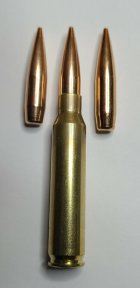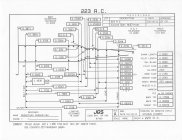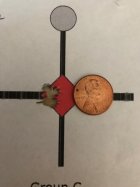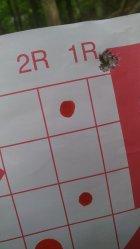So ive been pondering this same thing, i want to be able to clear the donut that forms on about the 3rd firing, id like to keep the edge of the bullet just out of reach of the donut. This should give you room to run 25 gr of varget with no crunch..
i was tood the ISSF reamer is the ticket, I was looking at that one or one with .169 freebore.
id shoot 60-85 gr bullets exclusively.
PTG's 223 Rem ISSF reamer cuts 0.169 fb and was specifically designed with 90s in mind. The caveat is that the folks involved with that reamer design were seating 90s at around .010" into the lands. It turns out in some people's hands, the 90s also shoot very well at around .020" to .025"
off the lands. In that event, you're giving up ~.030" to .035" fb as compared to those seating them .010" into the lands. The boattail/bearing surface junction of a 90 VLD seated at .020" to .025"
off the lands is right at, or just slightly below the neck/shoulder junction. In other words, they will be seated well
below the donut in that particular chamber when jumped, which is not optimal. A more optimal freebore for the 90s would be in the 0.220" to 0.230" range if one plans to jump them.
I mentioned the above solely for comparative purposes. In rifles chambered with the 223 Rem ISSF reamer (0.169" fb), it is still possible to seat the Berger 80.5 Fullbore bullet, which has a BTO dimension ~.033" shorter than the 90 VLD (.589" vs .622"). As you might imagine, if the 90 VLD boattail/bearing surface junction is very close to the neck/shoulder junction when seated at ~.020" off the lands, those same chamber specs would put the Berger 80.5 Fullbore boattail/bearing surface junction approximately .033"
above the neck/shoulder junction when also seated at about .020" off the lands, or a little less than 1/4 of the way out the neck. To be honest, I don't know
exactly how far above the neck/shoulder the donut extends. I'm not sure there is any exact measurement. I would think putting the boattail/bearing surface junction at least 1/4th the way out the neck (above the neck/shoulder junction) would be the safest bet, but it may not require a full quarter of the neck length.
In any event, the best solution to this is to start making a few dummy rounds. Get the bullets you're interested in using seated exactly where you want them in the neck to avoid the donut, then start taking measurements. Your gunsmith may actually want the specific dummy rounds to work from, so hang on to any you make. Just note on the case body exactly what they are. Although I generally choose my reamer freebore specs based solely on
relative comparisons between optimized loads with a bullet I am already using in a given chamber of known freebore and one I wish to try, it can also be done by comparing actual measurements of the dummy rounds themselves, and knowing the specific segment dimensions of the bullet you wish to compare. Berger provides such bullet dimensional information. However, if you just give your smith the correct dummy round, it shouldn't be an issue to determine an appropriate freebore length. That can then be cut either using a throating reamer such as a Uni-throater, or by having a reamer ground with the appropriate throat dimensions. I haven't specifically made any dummy rounds myself with bullets in the 80 to 85.5 gr range, but I suspect the 223 Rem ISSF reamer (0.169" fb) would work almost perfectly. However, don't simply take my word for it, make a few dummy rounds and take some measurements, then discuss it with your smith. If the 223 Rem ISSF reamer will work for you, it would save a fair bit of lead time as that's one PTG usually has in stock (already made).














